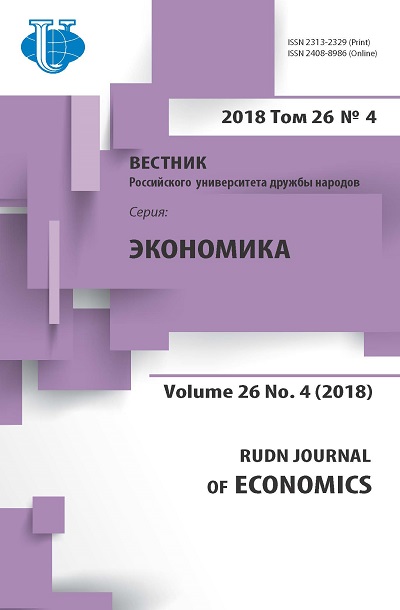Spatial differentiation of activity of nonresident buyers in the housing market in the Moscow region
- Authors: Kurichev N.K1, Kuricheva E.K2
-
Affiliations:
- Institute of Geography of the Russian Academy of Sciences
- Strelka KB
- Issue: Vol 26, No 4 (2018)
- Pages: 643-652
- Section: REGIONAL ECONOMY
- URL: https://journals.rudn.ru/economics/article/view/20757
- DOI: https://doi.org/10.22363/2313-2329-2018-26-4-643-652
Cite item
Full Text
Abstract
Housing construction in the Moscow agglomeration is closely linked with the migration of the population to the capital region. The acquisition of real estate by nonresident buyers in the primary market of the Moscow capital region (MСR) in the amount of 2.5 mln m2 provides housing for about 100 000 migrants per year, or about 40 % of the net migration inflow. Buyers from other regions account for 17 % of transactions in Moscow and 23 % in Moscow Oblast. The activity of buyers in the real estate market of the MCR has a spatial differentiation by the Russian regions, which is determined by the factors of natural resource rents, agglomeration effect, the status rents in the large cities, the distance from the MCR. Regional identity of buyers was determined by the addresses of their initial registration. Factor of natural resource rents is evident in the high share (6.4 %) of housing buyers in Moscow from Khanty-Mansi and Yamalo-Nenets Autonomous Okrugs that is almost four times higher than their share in the population. The factor of distance leads to exceeding 2.1 times the share of housing buyers in Moscow from the neighboring regions of the first order over their shares in the population. The greatest activity in the housing market of Moscow is characteristic for residents of cities with the 250 000-500 000 population, of Moscow Oblast - with the 100 000-250 000 population. The share of buyers from the million-plus cities (17.7 %) is slightly greater than their share in the population. Small towns and rural areas have weak buying activity in the housing market. Thus, the development of alternative to Moscow centers of attraction at the national level is associated with a change in migration incentives for residents of cities with 100 000-500 000 population.
About the authors
Nikolay K Kurichev
Institute of Geography of the Russian Academy of Sciences
Author for correspondence.
Email: nk.kurichev@gmail.com
PhD in Geography, Research Fellow at the Institute of Geography of the Russian Academy of Sciences
29 Staromonetny Lane, Moscow, 119017, Russian FederationEkaterina K Kuricheva
Strelka KB
Email: kuricheva@gmail.com
senior analyst at Strelka KB
6 Bersenevskaya Embankment, bldg. 3, Moscow, 119072, Russian FederationReferences
- Kurichev N.K., Kuricheva E.K. (2018). Vzaimosvyaz’ zhilishchnogo stroitel’stva v Moskovskoi aglomeratsii i migratsiya naseleniya v stolichnyi region [Interrelation of housing construction in the Moscow agglomeration and migration to the capital region]. Izv. Ros. akad. nauk. Seriya Geograficheskaya. No. 1. Pp. 5—20. (In Russ.)
- Makhrova A.G. (2006). Rynok zhil’ya i rasselenie v Moskovskom regione [Housing market and the settlement pattern in Moscow region]. Demoscope Weekly. No. 247—248. http://polit.ru/ article/2006/06/02/demoscope247 (accessed: 16.09.2017). (In Russ.)
- Makhrova A.G., Sternik G.M. (2005). Tendentsii i faktory razvitiya rynka zhil’ya v Moskovskoi oblasti [Trends and factors of housing market development in Moscow oblast]. Regional’nye Issledovaniya. No. 2(6). Pp. 50—62. (In Russ.)
- Regiony Rossii. Osnovnye sotsialno-ekonomicheskie pokazateli gorodov. 2016. Stat. sb [Regions of Russia. Main socioeconomic indicators of cities. 2016. Statistical Handbook]. Moscow: Rosstat Publ. 442 p.
- Bloze G. (2009). Interregional migration and housing structure in an East European transition country: A view of Lithuania 2001–2008. Baltic Journal of Economics. Vol. 9. No. 2. Pp. 47—66.
- Coleman A., Landon-Lane J. (2007). Housing markets and migration in New Zealand, 1962—2006. Reserve Bank of New Zealand. No. DP2007/12.
- Garriga C. et al. (2014). Rural-Urban Migration, Structural Transformation, and Housing Markets in China. Federal Reserve Bank of St. Louis. Working Paper Series. No. 2014—028.
- Gyourko J., Mayer C., Sinai T. (2013). Superstar cities. American Economic Journal: Economic Policy. Vol. 5. No. 4. Pp. 167—199.
- Hilber C.A.L., Rouw endal J., Vermeulen W. (2014). Local economic conditions and the nature of new housing supply. SERC Discussion paper 164.
- Kashnitsky I., Gunko M. (2016). Spatial variation of in-migration to Moscow: testing the effect of housing market. Cities. Vol. 59. Pp. 30—39.
- Saiz A. (2007). Immigration and housing rents in American cities. Journal of urban economics. Vol. 61. No. 2. Pp. 345—371.
- Vermeulen W., van Ommeren J. (2006). Housing supply and the interaction of regional population and employment. CPB Netherlands Bureau for Economic Policy Analysis. No. 65.















